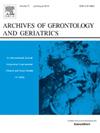社区老年人的肥胖指数轨迹及其与疼痛的关系:英国老龄化纵向研究的结果。
IF 3.5
3区 医学
Q2 GERIATRICS & GERONTOLOGY
引用次数: 0
摘要
背景:随着肥胖人数的增加,疼痛的发病率也随之增加,寻找预测疼痛风险的指标已成为当务之急。体重指数(BMI)、腹围(WC)和体重指数(WHtR)有可能成为很好的预测指标。然而,这些肥胖指标与各种疼痛的关系仍不清楚:这项纵向队列研究包括来自英国老龄化纵向研究(ELSA)的 2155 名无痛参与者(平均年龄 = 68.5 岁,标准差 [SD] = 8.6)。在第 0、2 和 4 波的护士访问中测量了 BMI、WC 和 WHtR。基于群体的轨迹模型 (GBTM) 被用来确定 BMI、WC 和 WHtR 的最佳轨迹。在第 4 波至第 9 波期间,对四个解剖部位(下背部、髋部、膝部和全身疼痛)的自我报告疼痛进行了评估。采用 Cox 比例危险模型估算肥胖指数与疼痛风险之间的危险比(HR)和 95% 置信区间(CI):在 7.49 年的中位随访期内,我们观察到 1,059 例全因疼痛病例。在对混杂因素进行调整后,与低稳定组相比,高稳定 WC 组的参与者发生疼痛的风险高出 30%(HR:1.30,95% CI:1.05-1.60,P = 0.014),而高稳定 WHtR 组的参与者发生疼痛的风险高出 29%(HR:1.29,95% CI:1.06-1.56,P = 0.010)。BMI、WC和WHtR的高稳定轨迹也与背部、髋部和膝部疼痛风险升高有关:本研究发现长期肥胖指数是疼痛的重要预测因素,这表明监测这些指标对有效进行临床风险评估非常重要。还需要进一步的研究来探索这些关联的内在机制。本文章由计算机程序翻译,如有差异,请以英文原文为准。
Trajectories of obesity indices and their association with pain in community-dwelling older adults: Findings from the English longitudinal study of ageing
Background
The prevalence of pain has increased with the increase of obesity, and finding indicators to predict pain risk has become an urgent need. BMI, WC, and WHtR have the potential to be excellent predictors. However, the association of these obesity indicators with various pains remains unclear.
Methods
This longitudinal cohort study included 2155 pain-free participants (mean age = 68.5 years, standard deviation [SD] = 8.6) from the English Longitudinal Study of Ageing (ELSA). BMI, WC, and WHtR were measured during nurse visits at waves 0, 2, and 4. The Group-Based Trajectory Model (GBTM) was used to identify optimal trajectories for BMI, WC, and WHtR. Self-reported pain at four anatomical sites (lower back, hip, knee and total pain) was assessed at Waves 4 to 9. Cox proportional hazards models were employed to estimate hazard ratios (HR) and 95% confidence intervals (CI) for the association between obesity indices and pain risk.
Results
Over a median follow-up period of 7.49 years, we observed 1,059 incident cases of all-cause pain. After adjusting for confounders, participants in the High-Stable WC group had a 30% higher risk of experiencing pain (HR: 1.30, 95 % CI: 1.05–1.60, P = 0.014), while those in the High-Stable WHtR group had a 29% higher risk (HR: 1.29, 95% CI: 1.06–1.56, P = 0.010) compared to the Low-Stable group. High-stable trajectories for BMI, WC, and WHtR were also associated with an elevated risk of back, hip, and knee pain.
Conclusion
This study identifies long-term obesity indices as significant predictors of pain, suggesting the importance of monitoring these measures for effective clinical risk assessments. Further research is needed to explore the underlying mechanisms of these associations.
求助全文
通过发布文献求助,成功后即可免费获取论文全文。
去求助
来源期刊
CiteScore
7.30
自引率
5.00%
发文量
198
审稿时长
16 days
期刊介绍:
Archives of Gerontology and Geriatrics provides a medium for the publication of papers from the fields of experimental gerontology and clinical and social geriatrics. The principal aim of the journal is to facilitate the exchange of information between specialists in these three fields of gerontological research. Experimental papers dealing with the basic mechanisms of aging at molecular, cellular, tissue or organ levels will be published.
Clinical papers will be accepted if they provide sufficiently new information or are of fundamental importance for the knowledge of human aging. Purely descriptive clinical papers will be accepted only if the results permit further interpretation. Papers dealing with anti-aging pharmacological preparations in humans are welcome. Papers on the social aspects of geriatrics will be accepted if they are of general interest regarding the epidemiology of aging and the efficiency and working methods of the social organizations for the health care of the elderly.

 求助内容:
求助内容: 应助结果提醒方式:
应助结果提醒方式:


